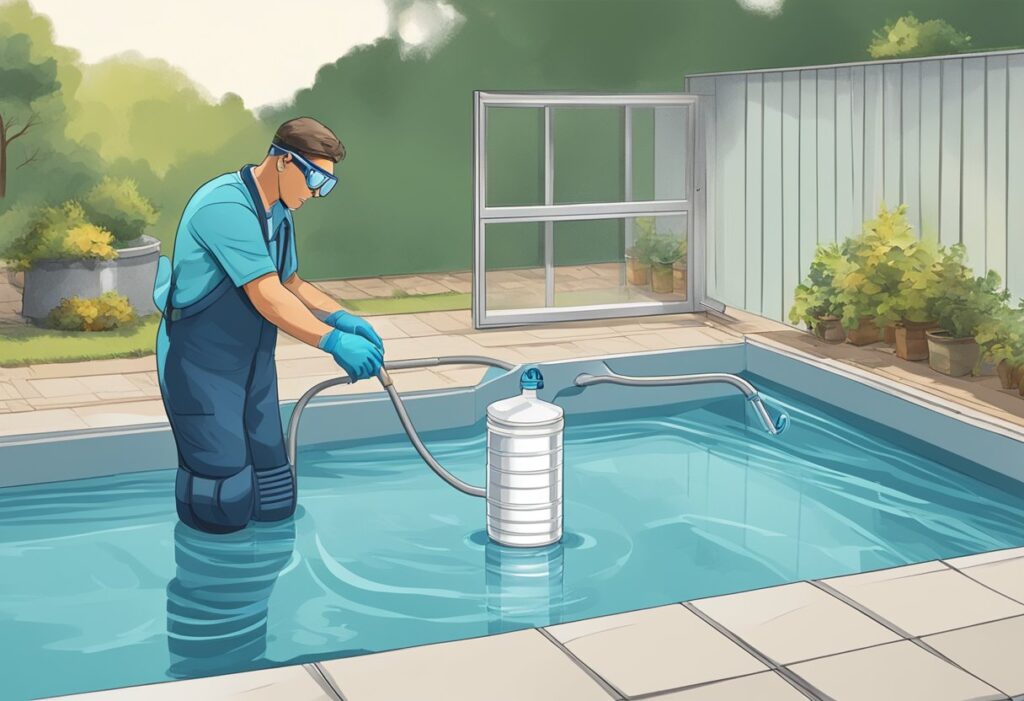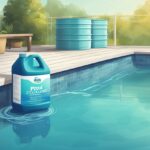Muriatic acid, also known as hydrochloric acid, is a potent chemical employed to maintain the proper pH and alkalinity levels in your pool. Its ability to effectively reduce the total alkalinity and pH balance is crucial for preventing scale formation and maintaining the clarity and health of the pool water. However, it’s important to respect the strength of this acid due to its powerful and corrosive nature. Safety should always be your top priority when handling muriatic acid to avoid any potential harm to yourself or the pool surfaces.

Before you start, it’s essential to wear the right protective gear. Safety goggles, gloves, and a respirator are necessary to shield yourself from harmful fumes and splashes. Always introduce muriatic acid to water, never water to acid, to prevent a potentially dangerous reaction. Adding the acid to your pool requires careful handling and precise dosing, ensuring the chemical is distributed evenly and effectively. Remember to pour it slowly into the deep end of the pool while the filtration system is running to aid in dispersing the acid throughout the water.
Maintaining your pool’s chemistry is an ongoing task that demands attention and knowledge about the chemicals involved. Beyond the initial application, keep a vigilant eye on the water’s pH and alkalinity levels, periodically retesting and adjusting as needed. This consistent monitoring ensures that the use of muriatic acid contributes to a safe and enjoyable swimming environment.
Understanding Pool Chemistry
Managing your pool’s chemistry is crucial for safe and enjoyable swimming. A proper balance of pH levels, types of acids used, and maintaining alkalinity is essential to preserve both the health of the swimmers and the integrity of the pool infrastructure.
Balancing pH Levels
The pH scale measures how acidic or basic your pool water is, with a range of 0 to 14. You’ll aim for an ideal pH level between 7.2 and 7.6 to ensure comfort and effective sanitation. Muriatic acid, also known as hydrochloric acid, is commonly used to lower high pH levels in your pool water, helping maintain the right balance.
Differentiating Acids
Understanding the difference between commonly used acids can help you choose the right products for your pool maintenance:
- Muriatic Acid (Hydrochloric Acid) reduces both pH and alkalinity. It’s a strong acid and should be handled with care.
- Sulfuric Acid is another option that may be used in automatic pH control systems but isn’t as typically recommended due to potential harm to pool plaster and the need for correct handling.
Maintaining Alkalinity
Total alkalinity, measured in parts per million (ppm), is the water’s capacity to neutralise acids and maintain stable pH levels. Aim for an alkalinity level of 80-120 ppm. If your alkalinity levels are too high, muriatic acid can be added to bring it down to the optimal range. This will help stabilise your pH balance and prevent the water from becoming too acidic or basic.
Safe Handling of Muriatic Acid
When using muriatic acid in your pool, it’s crucial to handle the substance with utmost care. The following guidelines will ensure that safety is maintained and risks are minimised during the process.
Personal Protective Equipment
Before handling muriatic acid, you must wear the appropriate safety gear to protect yourself from hazardous fumes and potential splashes that can cause burns and irritation.
- Gloves: Wear acid-resistant gloves, such as those made from PVC or butyl rubber.
- Eye Protection: Use goggles or a face shield to guard against accidental splashes.
- Respirator: In well-ventilated areas, a mask may suffice, but in enclosed spaces, use a respirator with cartridges that are rated for acid fumes.
Preparing and Diluting Acid
Muriatic acid must be diluted before use to minimise the risk of a chemical reaction that can lead to the release of chlorine gas and potentially hazardous fumes.
- Fill a plastic bucket with water; never use a metal container due to the risk of corrosion.
- Gradually add muriatic acid to the water, following the manufacturer’s recommended ratio, typically one part acid to ten parts water.
- Stir the solution gently with a plastic or acid-resistant tool.
Note: Always add acid to water, not water to acid, to prevent a potentially dangerous exothermic reaction.
Storage and Disposal
Proper storage and disposal of muriatic acid are as important as the safe handling of the chemical.
- Storage: Keep muriatic acid in its original container, tightly sealed, and away from direct sunlight and heat sources. Store in a cool, dry, and well-ventilated location.
- Disposal: Never pour unused muriatic acid down the drain. Check with your local council for hazardous waste disposal guidelines or take it to a recycling centre that accepts chemicals.
By adhering to these instructions, you’ll ensure muriatic acid is handled safely in your pool maintenance routine.
Cleaning and Maintenance Procedures
When using muriatic acid in your pool, you’re primarily dealing with the removal of stains and scaling, and the management of pool equipment. It’s essential to conduct these procedures with care to maintain a pristine pool while ensuring the safety of your swimming environment.
Removing Stains and Scaling
To address stains and scaling on your pool’s surfaces, particularly concrete pool surface stains or calcium deposits, you can use muriatic acid. Follow these steps:
-
Test: Check your pool water’s pH levels; muriatic acid lowers both the pH and alkalinity.
-
Preparation: Protect yourself with appropriate gear — gloves, eye protection, and a respirator.
-
Dilution: Mix 1 part muriatic acid with 10 parts water in a clean plastic bucket always adding acid to water, not water to acid.
-
Application: Pour the diluted acid directly onto the stained area, avoiding unnecessary contact with unaffected areas.
-
Scrubbing: Use a pool brush to scrub the surface gently.
-
Neutralisation: After cleaning, neutralise the acid with baking soda (sodium bicarbonate) before safely draining away from the solution.
-
Rinsing: Thoroughly rinse the treated area with water.
-
Rebalance: Re-test and adjust your pool water chemistry.
Remember, never add water to acid as it can cause a dangerous reaction. Always add acid to water.
Managing Pool Equipment
Proper management of your filtration system and pool components such as the pump and pool filter, including cartridge filters, helps maintain the system’s efficiency and longevity.
-
Pump: Always turn off the pool pump before any maintenance to prevent injuries or damage to the system.
Cleaning Cartridge Filters:
- Remove the filter according to the manufacturer’s instructions.
- Prepare a cleaning solution of muriatic acid by diluting it with water in a large container.
- Soak the cartridge filter in the solution to dissolve mineral deposits and organic material.
- Rinse the filter thoroughly with clean water.
- Overall Filtration System: Regularly inspect the pool equipment for signs of wear or corrosion. Use muriatic acid to clean components, being sure to follow dilution and handling guidelines similar to the ones for removing surface stains.
By following these targeted procedures for cleaning and maintenance, you as a swimming pool owner can ensure your pool remains clean, clear, and in top-notch condition throughout the season.











